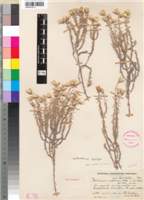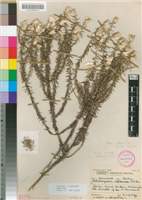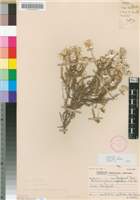Origin of name:
reflexum = bent back sharply
Diagnostic characters:
Cream bracts, white-tippedLarge solitary headsSmall needle-like leaves, bent downwards
Description:
Twiggy shrublet 300�600 mm tall, young stems thinly white-woolly, glandular-pubescent, closely leafy throughout. Leaves spreading, later reflexed, 5�11 x 0.75�1.5 mm, linear or linear-lanceolate, very acute, apiculate, bases broad, half-clasping, margins strongly revolute, glandular-pubescent above, sometimes thinly greyish-white woolly as well, densely white-woolly below. Heads heterogamous or rarely homogamous, campanulate, c. 10�12 mm long, double that across the fully radiating bracts, solitary at branchlet tips. Involucral bracts in c. 10 series, graded, imbricate, inner much exceeding flowers, acute, glossy white, outer tinged light brown often with a rosy cast. Receptacle shortly honeycombed. Flowers 124�222, (0�) 3�31 female, 97�196 homogamous. Achenes 1 mm long, glabrous. Pappus bristles many, equaling corolla, barbellate above, bases not cohering.
Flowering mainly between February and April.
Distribution:
Locally common among rock outcrops. Recorded from the mountains of Mpumalanga and Swaziland, from Hebronberg above the Blyde River Canyon south to the Steenkampsberge and the Barberton Mountains.
Grassland and Savanna Biomes.
Notes:
Easily recognized by its stiff strongly reflexed leaves with markedly revolute margins.
Taxonomy:
Literature:
Helichrysum reflexum N.E. Br. in Kew Bull. 1894: 356 (1894); Compton, Fl. Swaziland 634 (1976).
Type:
Mpumalanga, Barberton, Saddleback Mt., 5 000 ft, 11 v 1890, Galpin 947 (K, holo.; BOL; PRE; Z, iso.).
Synonym(s):
Vouchers:
Codd 6430 (PRE); Compton 27684 (NBG; PRE); Galpin 14399 (BM); Hilliard & Burtt 14166 (E; K; M; MO; NU; PRE; S); Rogers 19940 (PRE).

_sml.jpg)
_sml.jpg)
_sml.jpg)
_sml.jpg)
_sml.jpg)
_sml.jpg)



